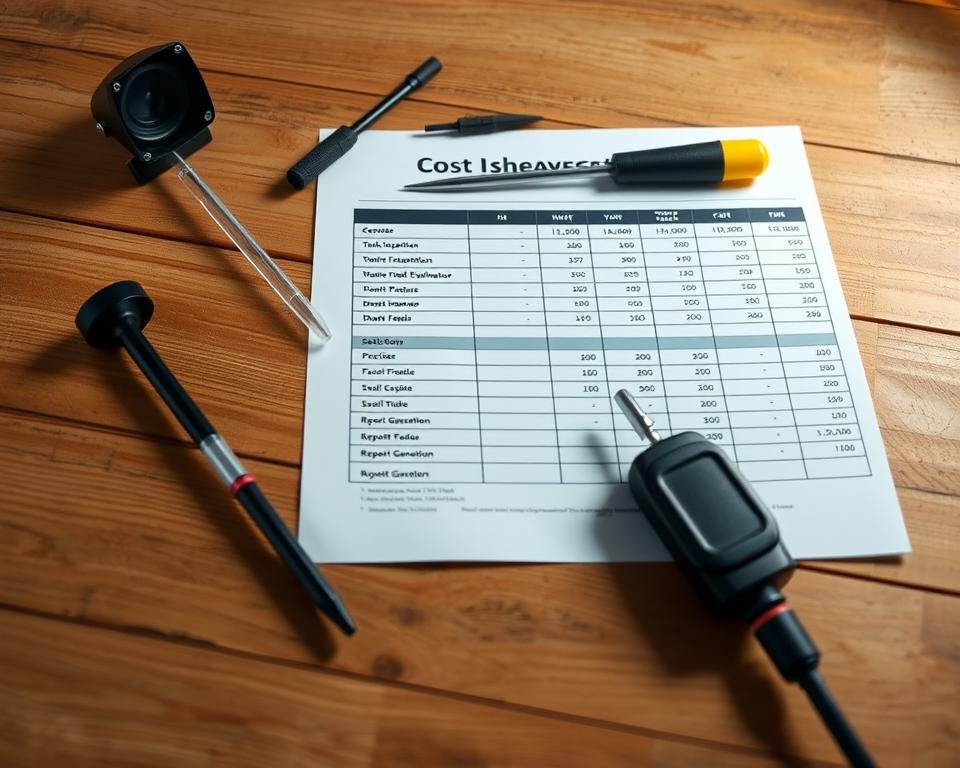Septic Tank Pumping Price Explained
Have you wondered about the actual price of keeping your septic system up to date, or whether you’re spending more than necessary? It’s critical for property owners to understand the specifics of septic tank pumping prices. Typically, the fee is roughly $420, however it can vary considerably. This difference stems from elements like your tank’s size and your location – septic pump out.
Routine maintenance of your septic tank prevents costly remedies, highlighting the importance of understanding service costs. We aim to examine septic tank service pricing thoroughly. This will allow you to budget money‑wise for your system’s maintenance.
Core Findings
- Average septic tank pumping runs about $420 USD.
- Prices can sit between $290 and $560 USD subject to various factors.
- Regular maintenance heads off pricier repairs later on.
- Most households need pumping every 3–5 years.
- Family size and consumption can affect pumping schedule.
Grasping the Importance of Septic Tank Pumping
Septic tank pumping is essential for a smooth‑running effluent system. It gets rid of solids that, if not addressed, create blockages. Timely pumping also stops bad smells but also dodges high repair costs.
Neglecting septic tank maintenance can threaten our extensive reliance on these systems. Thankfully, reasonably priced services minimize the risk of system failure. Regular upkeep extends your septic system’s life, ensuring smooth operation.
Cost data for septic tank upkeep teaches the value of proactive care. Maintenance detects problems at an initial stage, avoiding severe damage and steep repair bills. Routine pumping is a prudent move for homeowners to protect their asset and gain peace of mind.
Average Costs for Septic Tank Pumping
Septic tank pumping generally comes between $250 and $600 USD in cost. Most times, homeowners will spend about $400 for this essential service. Fee differences are driven by variables like capacity, property location, and how often maintenance is done. Common tanks, around 1,000 gallons, usually cost between $225 and $400 USD.
Homeowners should remember the need of budgeting funds every three to five years for septic tank pumping. This scheduled care relies on the usage level and size. It helps avert bigger, more expensive issues down the road, showing to be both labor and budget friendly.

Elements Shaping Septic Tank Pumping Prices
A number of factors are key in determining the price of septic tank pumping. Grasping these details enables homeowners to budget for these essential services wisely.
The volume counts immensely. Higher‑capacity tanks take more work and materials to empty, which translates into elevated fees. The accessibility to your tank also significantly influences the price. Tanks installed deeply or in difficult locations necessitate more time and special tools from technicians, thus hiking the labor costs.
Costs can swing widely based on where you live. This is due to differences in local labor rates and disposal fees. For example, some areas have higher charges for removing waste, impacting the overall service cost. Moreover, tanks with heavy solid waste accumulation also incur additional fees—anywhere from $100 USD to $300 USD. Plus, the more frequently a tank requires pumping—due to higher water usage—the higher the ongoing expenses.
Septic Tank Capacity and Its Effect on Cost
The size of your septic tank directly affects the cost of its upkeep. Lower‑capacity tanks, for example, those that can hold 750 gallons, typically have lower pumping costs, usually ranging from $175 USD to $300. On the other hand, bigger tanks, capable of holding up to one thousand seven hundred fifty gallons, may incur charges between $400 and $700. The majority of single‑family residences have tanks that hold between 1,000 to 1,250 gallons, offering a balance between capacity and function.
Households with compact systems or large households often need more frequent pumping services, which raises the overall expense. It’s vital to conduct regular septic tank inspections in these situations. This ensures the tank does not overflow or fail, which prevents additional problems. By understanding the link between tank size and service fees, homeowners can reach smart choices regarding their septic systems and their upkeep needs.
Location‑Based Changes in Septic Tank Pumping Costs
Septic tank pumping costs can differ greatly based on location. In urban areas, the expenses are typically higher due to local septic services having increased overhead. For example, Minneapolis, MN residents may spend between $180 and $280, while those in Portland, OR could see prices from $440 to $750.
The reasons behind these differences are many. They include local living costs, need for septic specialists, and area‑specific regulations. In places where septic services are in short supply, homeowners might spend extra due to the service scarcity. Moreover, tough regulations in some regions can raise the need for higher compliance fees, influencing the cost of services.
Knowing about these geographic cost variances is crucial for homeowners. It allows them to plan their septic maintenance spending more accurately. By recognizing local pricing, they can seek quotes from specialists prudently, servicing their septic system effectively without overspending.
Extra Expenses to Consider with Septic Tank Pumping
Homeowners often overlook various additional maintenance costs connected with septic tank pumping. The core cost pays for just the standard service, excluding other potential expenses. Understanding these can aid in creating a full budget.
Video line checks, for instance, fall between $250 USD to $500. They offer a minimally disruptive look into the system’s condition. Additionally, filter rinsing, which if ignored can lead to system failures, represents another cost.
The range for repairs can be broad, from $100 to $4,000, according to the specific issues. This spread emphasizes the need of factoring in additional maintenance costs for future budgeting.
Planning for Septic Tank Maintenance
When planning for septic tank upkeep, it’s important to embrace a all‑inclusive view. This includes a few critical elements. Due to variable factors, the cost of maintenance can shift considerably. Therefore, smart financial planning is key.
To ensure your system functions smoothly and to sidestep surprise bills, keep these periods and services in mind:
- Routine pumping: This service is generally required every three to five years.
- Inspections: Set aside for around $250 to $1,180 for inspections every three years.
- Potential repairs: Reserve a fund for surprise repairs, which can arise unexpectedly.
Creating a recurring maintenance calendar with a reliable septic service is key. By expecting these expenses, homeowners can avoid the steep costs tied to neglect. This method ensures the life span and effectiveness of their septic systems.
Common Signs That Your Septic Tank Needs Pumping
Remaining vigilant to your septic system’s condition is crucial. Spot the early signs that suggest your septic tank requires pumping. Doing so can avoid serious damage and reduce repair costs.
- Slow drains: Water taking longer to drain in sinks, tubs, or toilets could signal your septic tank is too full.
- Unpleasant odors: Bad smells around the septic tank or in your yard are frequently clear indicators of a problem.
- Gurgling sounds: Odd gurgling from your plumbing might suggest air is trapped because of a blockage.
- Wet spots: Puddles or lush grass patches near the drain field suggest waste seepage from the tank.
- Dark green grass: Grass that is deeper green and appears robust around the drain field may indicate leakage of nutrients, suggesting an issue.
Scheduled checks by septic system specialists can ensure your tank is in healthy condition. Relying on experienced septic technicians for maintenance avoids these issues, ensuring your system’s longevity.
Advantages of Consistent Septic Tank Inspections
Regular inspections are key to keeping your septic system in excellent order. They pinpoint potential problems before they become costly repairs. By engaging professionals for these checks, every part of your system receives a thorough assessment.
The process examines several parts of your system, including waste levels and the drain field’s state. It verifies that critical parts, like baffles, work as they should. Catching issues early helps prevent harmful overflows and shields the environment, helping both your home and the wider community.
Getting your septic tank evaluated every three years can cut a lot of money. It stops bigger issues from developing due to neglect. This not only saves on repair costs but also ensures your peace of mind.
| Inspection Aspect | Importance |
|---|---|
| Waste Level Assessment | Prevents overflow and backups |
| Drain Field Evaluation | Identifies saturation and function |
| Component Functionality Check | Ensures proper system operation |
| Early Problem Detection | Saves on repair costs |
Ways to Save on Septic Tank Pumping Prices
Homeowners looking to reduce septic tank pumping costs have multiple strategic options. Arranging group services with neighbors is one effective method. This involves teaming up with others nearby to schedule services together, potentially securing group discounts. It’s a way to boost community bonds while trimming expenses more effectively.
Another helpful approach is to sign up for maintenance plans with septic service providers. These plans often include lower fees for scheduled check‑ups and pumpings, maintaining septic systems functioning properly at a lower cost. Homeowners are encouraged to ask about these plans when contacting service companies.
Keeping the septic tank accessible can also lower pumping expenses. Clear accessibility means there’s no requirement for extra labor charges. It’s smart to keep the area around the tank clear of clutter, making way for straightforward servicing.
Practicing certain habits helps in extending the time between pumpings as well. Cutting back on water usage and limiting garbage disposal use are important practices. These actions can significantly boost septic system health, lowering the need for regular maintenance. By implementing these habits, homeowners can efficiently cut their septic tank pumping costs, preserving their wallets and systems.
The Bottom Line
Guaranteeing routine septic tank pumping is essential for homeowners who want to keep their waste management system healthy and effective. Understanding about the costs involved allows for effective budgeting. This way, you can get cost‑effective septic services without compromising your system’s functionality.
Adopting a forward‑thinking approach to maintenance is extremely rewarding. By watching for clues that show the need for pumping, you can avoid costly repairs and lengthen your system’s lifespan. Such actions not only enhance your home’s functionality but also offer you peace of mind.
In conclusion, maintaining regular inspections and timely septic tank pumping is essential for effective home maintenance. By prioritizing proper planning and focusing on affordable septic service, you’ll secure your septic system remains operational and reliable for many years.


